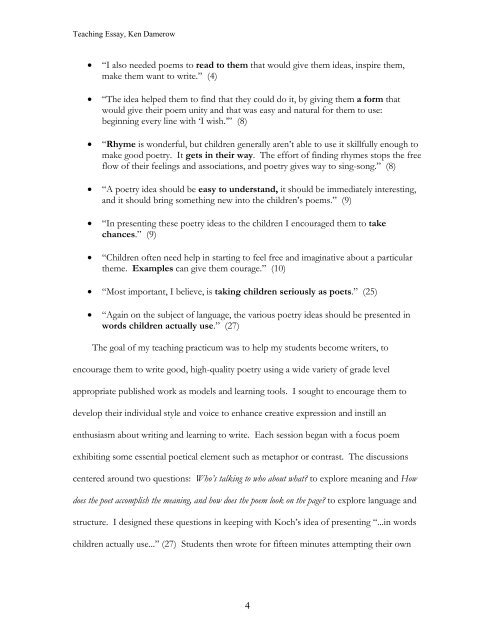An Example of a Teaching Essay - Goddard College's Intranet
An Example of a Teaching Essay - Goddard College's Intranet
An Example of a Teaching Essay - Goddard College's Intranet
Create successful ePaper yourself
Turn your PDF publications into a flip-book with our unique Google optimized e-Paper software.
<strong>Teaching</strong> <strong>Essay</strong>, Ken Damerow<br />
• “I also needed poems to read to them that would give them ideas, inspire them,<br />
make them want to write.” (4)<br />
• “The idea helped them to find that they could do it, by giving them a form that<br />
would give their poem unity and that was easy and natural for them to use:<br />
beginning every line with ‘I wish.’” (8)<br />
• “Rhyme is wonderful, but children generally aren’t able to use it skillfully enough to<br />
make good poetry. It gets in their way. The effort <strong>of</strong> finding rhymes stops the free<br />
flow <strong>of</strong> their feelings and associations, and poetry gives way to sing-song.” (8)<br />
• “A poetry idea should be easy to understand, it should be immediately interesting,<br />
and it should bring something new into the children’s poems.” (9)<br />
• “In presenting these poetry ideas to the children I encouraged them to take<br />
chances.” (9)<br />
• “Children <strong>of</strong>ten need help in starting to feel free and imaginative about a particular<br />
theme. <strong>Example</strong>s can give them courage.” (10)<br />
• “Most important, I believe, is taking children seriously as poets.” (25)<br />
• “Again on the subject <strong>of</strong> language, the various poetry ideas should be presented in<br />
words children actually use.” (27)<br />
The goal <strong>of</strong> my teaching practicum was to help my students become writers, to<br />
encourage them to write good, high-quality poetry using a wide variety <strong>of</strong> grade level<br />
appropriate published work as models and learning tools. I sought to encourage them to<br />
develop their individual style and voice to enhance creative expression and instill an<br />
enthusiasm about writing and learning to write. Each session began with a focus poem<br />
exhibiting some essential poetical element such as metaphor or contrast. The discussions<br />
centered around two questions: Who’s talking to who about what? to explore meaning and How<br />
does the poet accomplish the meaning, and how does the poem look on the page? to explore language and<br />
structure. I designed these questions in keeping with Koch’s idea <strong>of</strong> presenting “...in words<br />
children actually use...” (27) Students then wrote for fifteen minutes attempting their own<br />
4



